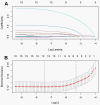Risk factors and prediction model for acute ischemic stroke after off-pump coronary artery bypass grafting based on Bayesian network
- PMID: 39563346
- PMCID: PMC11577910
- DOI: 10.1186/s12911-024-02762-2
Risk factors and prediction model for acute ischemic stroke after off-pump coronary artery bypass grafting based on Bayesian network
Abstract
Background: This study aimed to identify the risk factors of acute ischemic stroke (AIS) occurring during hospitalization in patients following off-pump coronary artery bypass grafting (OPCABG) and utilize Bayesian network (BN) methods to establish predictive models for this disease.
Methods: Data were collected from the electronic health records of adult patients who underwent OPCABG at Beijing Anzhen Hospital from January 2018 to December 2022. Patients were allocated to the training and test sets in an 8:2 ratio according to the principle of randomness. Subsequently, a BN model was established using the training dataset and validated against the testing dataset. The BN model was developed using a tabu search algorithm. Finally, receiver operating characteristic (ROC) and calibration curves were plotted to assess the extent of disparity in predictive performance between the BN and logistic models.
Results: A total of 10,184 patients (mean (SD) age, 62.45 (8.7) years; 2524 (24.7%) females) were enrolled, including 151 (1.5%) with AIS and 10,033 (98.5%) without AIS. Female sex, history of ischemic stroke, severe carotid artery stenosis, high glycated albumin (GA) levels, high D-dimer levels, high erythrocyte distribution width (RDW), and high blood urea nitrogen (BUN) levels were strongly associated with AIS. Type 2 diabetes mellitus (T2DM) was indirectly linked to AIS through GA and BUN. The BN models exhibited superior performance to logistic regression in both the training and testing sets, achieving accuracies of 72.64% and 71.48%, area under the curve (AUC) of 0.899 (95% confidence interval (CI), 0.876-0.921) and 0.852 (95% CI, 0.769-0.935), sensitivities of 91.87% and 89.29%, and specificities of 72.35% and 71.24% (using the optimal cut-off), respectively.
Conclusion: Female gender, IS history, carotid stenosis (> 70%), RDW-CV, GA, D-dimer, BUN, and T2DM are potential predictors of IS in our Chinese cohort. The BN model demonstrated greater efficiency than the logistic regression model. Hence, employing BN models could be conducive to the early diagnosis and prevention of AIS after OPCABG.
Keywords: Bayesian network; Coronary artery bypass grafting; Prediction model; Risk factor; Stroke; Type 2 diabetes mellitus.
© 2024. The Author(s).
Conflict of interest statement
Figures





Similar articles
-
A Bayesian network-based approach for identifying risk factors and predicting ischemic stroke in infective endocarditis patients.Front Cardiovasc Med. 2024 Jan 5;10:1294229. doi: 10.3389/fcvm.2023.1294229. eCollection 2023. Front Cardiovasc Med. 2024. PMID: 38259317 Free PMC article.
-
[Short-term clinical outcomes and risk factors associated with in-hospital mortality in patients undergoing off-pump coronary artery bypass grafting].Zhonghua Yi Xue Za Zhi. 2017 Apr 25;97(16):1218-1221. doi: 10.3760/cma.j.issn.0376-2491.2017.16.007. Zhonghua Yi Xue Za Zhi. 2017. PMID: 28441848 Chinese.
-
Role of pre-operative red cell distribution width estimation in the prediction of in-hospital mortality after off-pump coronary artery bypass grafting.J Cardiothorac Surg. 2021 Aug 13;16(1):232. doi: 10.1186/s13019-021-01612-w. J Cardiothorac Surg. 2021. PMID: 34389026 Free PMC article.
-
Influencing factors for early acute cerebrovascular accidents in patients with stroke history following off-pump coronary artery bypass grafting.Heart Lung Circ. 2014 Jun;23(6):560-5. doi: 10.1016/j.hlc.2013.11.017. Epub 2014 Jan 22. Heart Lung Circ. 2014. PMID: 24513488
-
Off-pump coronary artery bypass grafting improves short-term outcomes in high-risk patients compared with on-pump coronary artery bypass grafting: Meta-analysis.J Thorac Cardiovasc Surg. 2016 Jan;151(1):60-77.e1-58. doi: 10.1016/j.jtcvs.2015.08.042. Epub 2015 Aug 15. J Thorac Cardiovasc Surg. 2016. PMID: 26433633 Review.
References
-
- Bakaeen FG, Gaudino M, Whitman G, Doenst T, Ruel M, Taggart DP, Stulak JM, Benedetto U, Anyanwu A, Chikwe J, Bozkurt B, Puskas JD, Silvestry SC, Velazquez E, Slaughter MS, McCarthy PM, Soltesz EG, Moon MR. 2021: The american association for thoracic surgery expert consensus document: Coronary artery bypass grafting in patients with ischemic cardiomyopathy and heart failure. J Thorac Cardiovasc Surg. 2021; 162: 829 – 50.e1. - PubMed
-
- Head SJ, Milojevic M, Domanski MJ, Farkouh ME, Kappetein AP: Reply. Stroke risk following anaortic off-pump cabg versus pci. J Am Coll Cardiol. 2018;72:2681. - PubMed
-
- Lorusso R, Moscarelli M, Di Franco A, Grazioli V, Nicolini F, Gherli T, De Bonis M, Taramasso M, Villa E, Troise G, Scrofani R, Antona C, Mariscalco G, Beghi C, Miceli A, Glauber M, Ranucci M, De Vincentiis C, Gaudino M. Association between coronary artery bypass surgical techniques and postoperative stroke. J Am Heart Assoc. 2019;8:e013650. - PMC - PubMed
-
- Mohamed MO, Hirji S, Mohamed W, Percy E, Braidley P, Chung J, Aranki S, Mamas MA. Incidence and predictors of postoperative ischemic stroke after coronary artery bypass grafting. Int J Clin Pract. 2021;75:e14067. - PubMed
MeSH terms
Grants and funding
- 82071342/National Natural Science Foundation of China
- 82071342/National Natural Science Foundation of China
- 82071342/National Natural Science Foundation of China
- 82071342/National Natural Science Foundation of China
- 82071342/National Natural Science Foundation of China
- 82071342/National Natural Science Foundation of China
- 82071342/National Natural Science Foundation of China
- 82071342/National Natural Science Foundation of China
- 82071342/National Natural Science Foundation of China
- 82071342/National Natural Science Foundation of China
- 82071342/National Natural Science Foundation of China
- 82071342/National Natural Science Foundation of China
LinkOut - more resources
Full Text Sources
Medical

